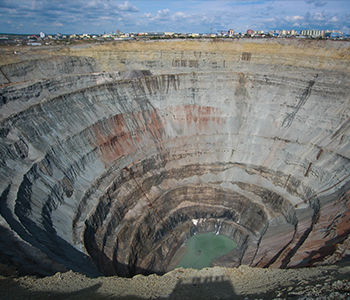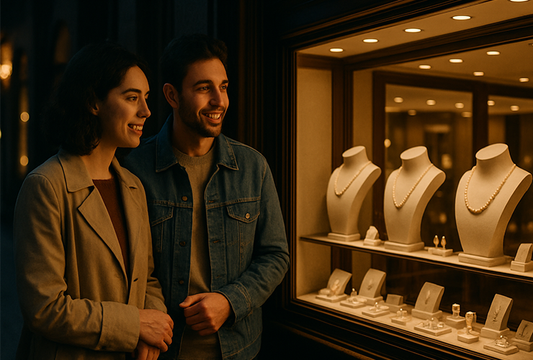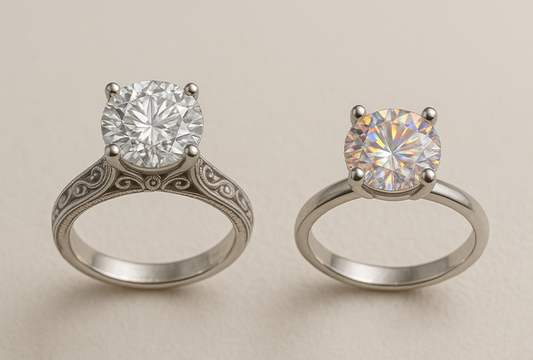For as long as humans have been making beautiful jewelry from precious metals, rocks and gemstones, diamonds have always taken center stage.
It’s not hard to see why - they are stunning, have a brilliant sparkle, and make you feel and look incredible.
What’s not to love?
And as we evolve as a species, so do our means to get diamonds.
Natural mined diamonds have always been around, and now you can experience lab-grown diamonds.
But what are lab-grown diamonds and are they expensive?
Should you consider lab-grown diamonds over natural diamonds for jewelry or engagement rings?
We’re going to tell you all about lab-grown diamonds, so you can make your mind up for yourself!
In this article...
- What defines a lab-grown diamond?
- How are lab-grown diamonds made?
- Is a lab-grown diamond a real diamond?
- The differences between lab-grown and real diamonds
- Do lab-grown diamonds get certified the same way as natural diamonds?
- Do lab-grown diamonds appreciate in value?
- Lab-Grown Diamonds vs Mined Diamond Cost Comparison
- Are lab-grown diamonds a good investment?
- What to look for in a lab grown diamond when buying?
What defines a lab-grown diamond?
You’ll have heard about the new-ish kid on the block, lab-grown diamonds, but what actually defines a lab-grown diamond?
In simple terms, a lab-grown diamond is a diamond that has been created in a laboratory setting using advanced technology, rather than being mined from the earth.
How are lab-grown diamonds made?
These diamonds are created using one of two methods: High-Pressure High Temperature (HPHT) or Chemical Vapor Deposition (CVD).
In HPHT, a small diamond seed is placed in a chamber with carbon-rich gasses, and subjected to high pressure and high temperature conditions that mimic the natural diamond-forming process.
If a lab-grown diamond is made via CVD, a diamond seed is placed in a chamber and exposed to a plasma of carbon-rich gasses, which deposit carbon atoms onto the seed, forming a diamond.

The best part is whichever method is used, the result is a diamond that is chemically, physically, and optically identical to natural diamonds. The only difference is the origin of the diamond!
You may also find that lab-grown diamonds are often referred to as “cultured diamonds” or “synthetic diamonds” to distinguish them from natural diamonds. Because they are made by humans, it’s also way easier to get them in a variety of colors, shapes and qualities.
A bonus is that they are typically less expensive than natural diamonds which will make your purse or wallet very happy indeed!
Is a lab-grown diamond a real diamond?
A store bought cake and a home baked cake are still considered cakes right?
The same goes for diamonds!
So, yes, a lab-grown diamond is a “real” diamond. It is made of the same chemical element, carbon, and has the same physical and optical properties as a natural diamond.
As we mentioned, the difference is that lab-grown diamonds are made by super smart scientists in a controlled laboratory rather than by mamma nature!
And if you want to be mega sure, the Federal Trade Commission (FTC) in the United States, defines a diamond as a mineral composed of pure carbon, therefore, lab-grown diamonds are considered real diamonds by the FTC.
What are the fundamental differences between lab-grown and natural diamonds?
There MUST be some differences between lab-grown and natural diamonds!
Well, technically, yes there are but the differences don’t affect the diamonds itself.
Of course, we’ve covered the main difference being the way the diamonds are made, natural diamonds form under the extreme pressure and heat deep in the earth. Thankfully, we learned how to master these conditions to make our own diamonds.
Natural diamond mining isn’t a sustainable process. The earth can’t replenish as quickly as we take, which makes lab-grown diamonds more sustainable and renewable in terms of market demand.
Diamond mining can also have a significant impact on the environment, including deforestation and destruction of habitats for wildlife, while lab-grown diamonds are produced in a controlled environment and have a much smaller environmental footprint.

There have been some concerns as to the amount of electricity that is used to make lab-grown diamonds, because, let’s put it this way, they require a lot of energy!
But, they don’t require nearly as much energy as it takes to mine diamonds - you can also get hold of lab-grown diamonds that only use 100% renewable energy to be made.
Our last point on the matter would be that natural diamonds take AGES to form. A few weeks, a few months? Millions of years, as it happens! So the more the world wants them, the rarer they become and the more expensive the price tag.
Lab-grown diamonds, they can be produced in a matter of weeks! This can make lab-grown diamonds far easier to get your hands on and less expensive than natural diamonds.
If you want an engagement ring with a large luscious diamond or extra bling for your jewelry but are working on a budget, lab-grown diamonds could be the answer to your dreams.
Do lab-grown diamonds get certified the same way as natural diamonds?
Yes, they do. The Gemological Institute of America has been certifying lab-grown diamonds since 2007. They now grade lab-grown diamonds with a Laboratory Diamond Report that references the GIA color, clarity and cut scales. The report also no longer refers to lab-grown diamonds as “synthetic”.
You should also look for the lab certification which is carried out by a third-party lab and specialist jeweler. Their report will evaluate the cut, clarity and color that you’d expect to find from a natural diamond certification.
Do lab-grown diamonds appreciate in value?
Sadly, this is the downside to buying a lab-grown diamond. They practically lose all their value the moment you buy them, and because they are so readily available, they aren’t expected to appreciate in value any time soon.
A natural diamond, on the other hand, generally retains 50% of its value which may increase or decrease over time depending on demand.
So, while lab-grown diamonds are cheaper on your wallet to start with, they aren’t a good investment if you’re looking to keep them as an asset or may be looking for something to sell on later in life.
Lab-Grown Diamonds vs Mined Diamond Cost Comparison
Lab-grown diamonds are typically less expensive than mined natural diamonds, on average, lab-grown diamonds are around 50-70% less expensive than natural diamonds of similar quality. However, the cost difference between the two types of diamonds can vary depending on the quality of the diamond.
However, it’s also worth noting that the cost of lab-grown diamonds can vary depending on the size, quality, and other factors.
For example, a large lab-grown diamond may be less expensive than a smaller natural diamond, while a high-quality lab-grown diamond may be more expensive than a lower quality natural diamond.
Some other food thought - the market for lab-grown diamonds is still relatively new and developing, so the cost of lab-grown diamonds may change over time!
Are lab-grown diamonds a good investment?
If we’re being really honest, we don’t believe diamonds should be bought as an investment at all. They should be bought because of their beauty, sparkle and the happiness they bring to their owner.
Featured Round Cut Diamond Engagement Rings
Gabriel & Co. Lelia Contemporary Diamond Engagement Ring
Gabriel & Co. Seina Octagonal Baguette Halo Diamond Engagement Ring
Ben Garelick Luna Twist Hidden Halo Black & White Diamond Engagement Ring
Gabriel & Co. "Reena" Diamond Engagement Ring
Ben Garelick Sargus Classic Large Center Round Diamond Shared Prong Engagement Ring
Ben Garelick Astra Galactic Head Round Diamond Engagement Ring
Ben Garelick Luna Twist Hidden Halo Diamond Engagement Ring
Ben Garelick Round Cut Orion Diamond Engagement Ring
But we know that many people like to know that their jewelry will retain some value should circumstances change or if they may want to upgrade it later down the line.
As we touched upon, lab-grown diamonds are not typically considered a good investment in the traditional sense, as they do not typically appreciate in value like natural diamonds do. Some jewelers and gemologists argue that they retain no value at all!
The value of a diamond is primarily determined by its rarity, and since lab-grown diamonds can be produced in a controlled environment in relatively large quantities, they are not as rare as natural diamonds.
The fact that lab-grown diamonds are typically less expensive than natural diamonds also affects their potential appreciation in value.
But it’s not all doom and gloom!
Lab-grown diamonds can be a good investment for certain consumers, particularly those looking for a sustainable or cost-effective alternative to natural diamonds.
And let’s face it, if you’re planning to keep your diamond forever, any diamond you love is a good investment!
What should a buyer look for in a lab-grown diamond?
When buying a lab-grown diamond, it is important to consider the same factors that you would when buying a natural diamond. These include:
Carat Weight: The carat weight of a diamond refers to its size, and is often used to determine the price of a diamond. Larger diamonds are typically more valuable than smaller diamonds. But a few other factors come into play here, including:
Cut: The cut of a diamond refers to the way it is cut and shaped. A well-cut diamond will have excellent symmetry and will reflect light well, giving it more sparkle and brilliance!
Color: The color of a diamond refers to the presence or absence of color in the diamond. The most valuable diamonds are colorless, while diamonds with a yellow or brown tint are less valuable.
Clarity: The clarity of a diamond refers to the presence or absence of internal and external flaws, known as inclusions and blemishes. Diamonds with fewer inclusions and blemishes are more valuable.
Certification: Look for a certification from a reputable organization such as the International Gemological Institute (IGI), the Gemological Institute of America (GIA), and the Hoge Raad voor Diamant (HRD), will have evaluated the diamond and provided a report on its quality characteristics. You can also check for its unique lab report!
Origin and Traceability: Some lab-grown diamond producers are more transparent than others, so it’s important to understand where the diamond came from and if it can be traced back to the laboratory.
We’re All Made of the Same Stuff
Diamonds are like humans. We’re all made of the same stuff deep down, and we’re all as precious as one another.
Lab-grown diamonds are as real as a diamond formed in the earth, their difference really lies in their availability and price.
These two factors are great benefits for consumers looking for a show stopping diamond without the added expense.
Lab-grown diamonds are becoming increasingly popular for engagement rings and jewelry of all kinds.
And we believe everyone deserves to wear diamonds!
Visit us at our Buffalo, NY store today. Not nearby? Not to worry - chat with our diamond experts online 24/7, call us at (716) 631-1584, or text (716) 574-0966. Let’s make your life shine with diamonds!

Peter Manka Jr. - Owner at Ben Garelick
Peter Manka Jr. is a passionate member of the family business who joined Ben Garelick in the early 2000s after working in product licensing for Sesame Workshop & The Jim Henson Company for many years. He obtained a degree in diamonds and jewelry from the prestigious Gemological Institute of America (GIA) in order to sharpen his jewelry skills. He takes great pride in providing exceptional customer service and helping clients find the perfect piece of jewelry.











